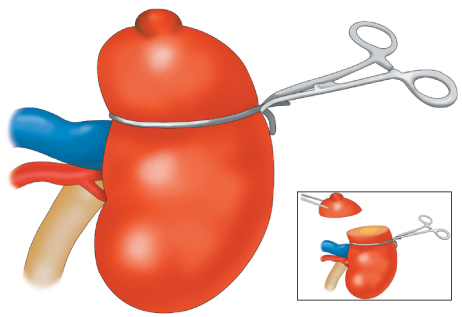Korean J Urol.
2010 Jan;51(1):8-14.
Efficacy of Parenchymal Compression in Open Partial Nephrectomies: A Comparison with Conventional Vascular Clamping
- Affiliations
-
- 1Department of Urology, Korea University School of Medicine, Seoul, Korea. dkyoon@korea.ac.kr
Abstract
- PURPOSE
We evaluated the efficacy of parenchymal compression in open partial nephrectomies (OPNs) compared with that of the conventional vascular clamping method. MATERIALS AND METHODS: OPNs were conducted by means of the parenchymal compression technique at our institution from April 2006. Among these, the operative outcomes of 20 consecutive patients with normal preoperative renal function (Group 1) were matched with those of 20 control patients from the database of previous operations who underwent OPN with a conventional vascular clamping method (Group 2). RESULTS: All preoperative characteristics were similar in both groups. The operative time was significantly higher for Group 2 (132.4+/-17.7 vs. 151.4+/-21.4 minutes, p=0.031). Estimated blood loss was slightly higher for Group 2, with marginal statistical significance (173.7+/-11.5 vs. 211.2+/-43.8 ml, p=0.06). Histologic examination revealed that over 80% of the tumors in both groups were renal cell carcinomas. For all patients, the pathology results of specimens were negative. Serum creatinine, checked at 1, 3, and 7 days after the operation, was significantly increased in both groups to a similar degree. However, 30 days after surgery, the patterns of serial serum creatinine levels demonstrated statistically significant differences by repeated-measures ANOVA (p<0.001), with a trend of more elevated in Group 2 than in Group 1, although values were within the normal range. No major complications occurred in either group. CONCLUSIONS: OPN using the parenchymal compression method had acceptable outcomes in terms of complete tumor control, avoiding warm ischemic time, and minimizing blooding, with good preservation of renal function and minimal complications.
Keyword
MeSH Terms
Figure
Reference
-
1. Novick AC. Wein AJ, Kavoussi LR, Novick AC, Partin AW, Peters CA, editors. Open surgery of the kidney. Campbell-Walsh urology. 2007. 9th ed. Philadelphia: Saunders;1720–1732.2. Huyghe E, Nohra J, Leobon B, El Khoury E, Khedis M, Soulié M, et al. Open partial nephrectomy with selective renal parenchymal control: a new reliable clamp. Urology. 2006. 68:658–660.3. Campbell SC, Novick AC, Streem SB, Klein E, Licht M. Complications of nephron sparing surgery for renal tumors. J Urol. 1994. 151:1177–1180.4. McDougall EM, Clayman RV, Chandhoke PS, Kerbl K, Stone AM, Wick MR, et al. Laparoscopic partial nephrectomy in the pig model. J Urol. 1993. 149:1633–1636.5. Cadeddu JA, Corwin TS, Traxer O, Collick C, Saboorian HH, Pearle MS. Hemostatic laparoscopic partial nephrectomy: cable-tie compression. Urology. 2001. 57:562–566.6. Gill IS, Munch LC, Clayman RV, McRoberts JW, Nickless B, Roemer FD. A new renal tourniquet for open and laparoscopic partial nephrectomy. J Urol. 1995. 154:1113–1116.7. Stifelman MD, Sosa RE, Nakada SY, Shichman SJ. Hand-assisted laparoscopic partial nephrectomy. J Endourol. 2001. 15:161–164.8. Brown JA, Hubosky SG, Gomella LG, Strup SE. Hand assisted laparoscopic partial nephrectomy for peripheral and central lesions: a review of 30 consecutive cases. J Urol. 2004. 171:1443–1446.9. Venkatesh R, Weld K, Ames CD, Figenshau SR, Sundaram CP, Andriole GL, et al. Laparoscopic partial nephrectomy for renal masses: effect of tumor location. Urology. 2006. 67:1169–1174.10. Hafez KS, Novick AC, Butler BP. Management of small solitary unilateral renal cell carcinomas: impact of central versus peripheral tumor location. J Urol. 1998. 159:1156–1160.11. Lee MS, Oh YT, Han WK, Rha KH, Choi YD, Hong SJ, et al. CT findings after nephron-sparing surgery of renal tumors. AJR Am J Roentgenol. 2007. 189:W264–W271.12. Smith SJ, Bosniak MA, Megibow AJ, Hulnick DH, Horii SC, Raghavendra BN. Renal cell carcinoma: earlier discovery and increased detection. Radiology. 1989. 170:699–703.13. Uzzo RG, Novick AC. Nephron sparing surgery for renal tumors: indications, methods and outcomes. J Urol. 2001. 166:6–18.14. Ghavamian R, Cheville JC, Lohse CM, Weaver AL, Zincke H, Blute ML. Renal cell carcinoma in the solitary kidney: an analysis of complications and outcome after nephron sparing surgery. J Urol. 2002. 168:454–459.15. Licht MR, Novick AC. Nephron sparing surgery for renal cell carcinoma. J Urol. 1993. 149:1–7.16. Denardi F, Borges GM, Silva W Jr, Stopiglia RM, Ferreira U, Billis A, et al. Nephron-sparing surgery for renal tumours using selective renal parenchymal clamping. BJU Int. 2005. 96:1036–1039.17. Cariou G, Cussenot O. Hemostasis technics in partial nephrectomy. Prog Urol. 1996. 6:605–606.18. Mejean A, Vogt B, Cazin S, Balian C, Poisson JF, Dufour B. Nephron sparing surgery for renal cell carcinoma using selective renal parenchymal clamping. J Urol. 2002. 167:234–235.19. Rodríguez-Covarrubias F, Gabilondo B, Borgen JL, Gabilondo F. Partial nephrectomy for renal tumors using selective parenchymal clamping. Int Urol Nephrol. 2007. 39:43–46.20. Tsivian A, Sidi AA. A simple and reliable hemostatic technique during partial nephrectomy. Urology. 2004. 63:976–978.21. Lam JS, Bergman J, Breda A, Schulam PG. Importance of surgical margins in the management of renal cell carcinoma. Nat Clin Pract Urol. 2008. 5:308–317.22. Joung JY, Jeong IG, Han KS, Yang SO, Jo YJ, Lee KH, et al. Partial nephrectomy using parenchymal compression without renal pedicle clamping. Korean J Urol. 2007. 48:265–269.
- Full Text Links
- Actions
-
Cited
- CITED
-
- Close
- Share
- Similar articles
-
- Partial Nephrectomy using Parenchymal Compression without Renal Pedicle Clamping
- Gasless Extraperitoneal Retroperitoneoscopically Assisted Surgery
- Clinical Observation on the Hemostasis of Partial Nephrectomy
- Comparison of Retroperitoneoscopic Nephrectomy with Open Nephrectomy
- Non-ischemic Partial Nephrectomy with Using the Microwave Tissue Coagulator



